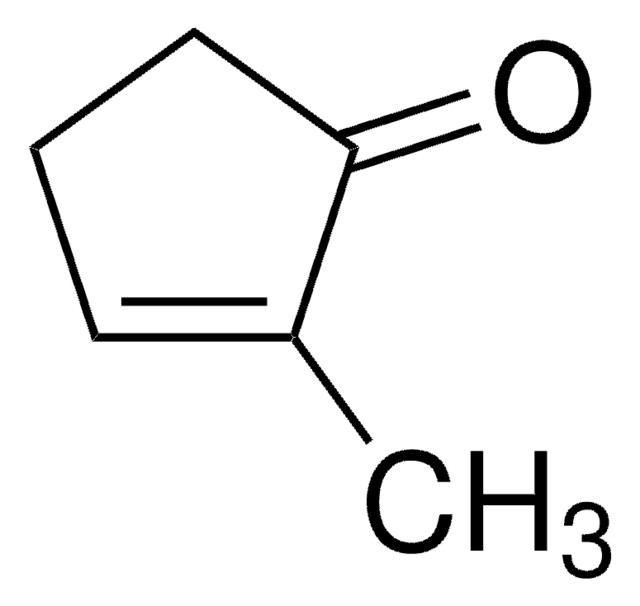302384
2,4,4,6-Tetrabromo-2,5-cyclohexadienone
90%
Sinónimos:
TBCO
Iniciar sesiónpara Ver la Fijación de precios por contrato y de la organización
About This Item
Fórmula empírica (notación de Hill):
C6H2Br4O
Número de CAS:
Peso molecular:
409.70
Número CE:
Número MDL:
Código UNSPSC:
12352100
ID de la sustancia en PubChem:
NACRES:
NA.22
Productos recomendados
Nivel de calidad
Análisis
90%
formulario
solid
grupo funcional
bromo
ketone
temp. de almacenamiento
2-8°C
cadena SMILES
BrC1=CC(Br)(Br)C=C(Br)C1=O
InChI
1S/C6H2Br4O/c7-3-1-6(9,10)2-4(8)5(3)11/h1-2H
Clave InChI
NJQJGRGGIUNVAB-UHFFFAOYSA-N
Categorías relacionadas
Descripción general
2,4,4,6-Tetrabromo-2,5-cyclohexadienone forms solid charge-transfer molecular complexes with 4-(aminomethyl)piperidine and their spectroscopic characteristics were studied.
Aplicación
2,4,4,6-Tetrabromo-2,5-cyclohexadienone was used as catalyst for efficient deoxygenation of sulfoxides to their corresponding sulfides with 1,3-dithiane. It was also used as reagent for conversion of alcohols to azides.
Palabra de señalización
Warning
Frases de peligro
Consejos de prudencia
Clasificaciones de peligro
Eye Irrit. 2 - Skin Irrit. 2 - STOT SE 3
Órganos de actuación
Respiratory system
Código de clase de almacenamiento
11 - Combustible Solids
Clase de riesgo para el agua (WGK)
WGK 3
Punto de inflamabilidad (°F)
Not applicable
Punto de inflamabilidad (°C)
Not applicable
Equipo de protección personal
dust mask type N95 (US), Eyeshields, Gloves
Elija entre una de las versiones más recientes:
¿Ya tiene este producto?
Encuentre la documentación para los productos que ha comprado recientemente en la Biblioteca de documentos.
Los clientes también vieron
Darren Van Essen et al.
Chemosphere, 266, 129195-129195 (2020-12-15)
Brominated flame retardants (BFRs) can enter aquatic environments where they can have adverse effects on organisms. The BFR, 1,2,5,6-Tetrabromocyclooctane (TBCO), has been introduced as a potential replacement for the major use BRF, Hexabromocyclododecane (HBCD). However, little is known about effects
Jakob Gustavsson et al.
Journal of chromatography. A, 1524, 74-86 (2017-10-17)
The influence of natural organic matter (NOM) on the solid-phase extraction (SPE) efficiency was investigated for legacy and emerging flame retardants (FRs; n=26) in surface water. Three different groups of FRs were analyzed: polybrominated diphenyl ethers (PBDEs), halogenated flame retardants
An efficient method for converting alcohols to azides with 2, 4, 4, 6-tetrabromo-2, 5-cyclohexadienone/PPh3 /Zn (N3)2? 2Py.
Saito A, et al.
Tetrahedron Letters, 38(22), 3955-3958 (1997)
Adel Mostafa et al.
Spectrochimica acta. Part A, Molecular and biomolecular spectroscopy, 118, 1012-1019 (2013-11-05)
The spectroscopic characteristics of the solid charge-transfer molecular complexes (CT) formed in the reaction of the electron donor 4-(aminomethyl) piperidine (4AMP) with the σ-acceptor iodine and the π-acceptors 2,3-dichloro-5,6-dicyano-1,4-benzoquinone (DDQ), 2,4,4,6-tetrabromo-2,5-cyclohexadienone (TBCHD) and 7,7,8,8-tetracyanoquinodimethane (TCNQ) have been studied in chloroform
Giulia Simonetti et al.
International journal of environmental research and public health, 17(11) (2020-05-31)
The occurrence of halogenated organic pollutants in indoor dust can be high due to the presence of textile, electronic devices, furniture, and building materials treated with these chemicals. In this explorative study, we focused on emerging organic pollutants, such as
Nuestro equipo de científicos tiene experiencia en todas las áreas de investigación: Ciencias de la vida, Ciencia de los materiales, Síntesis química, Cromatografía, Analítica y muchas otras.
Póngase en contacto con el Servicio técnico

